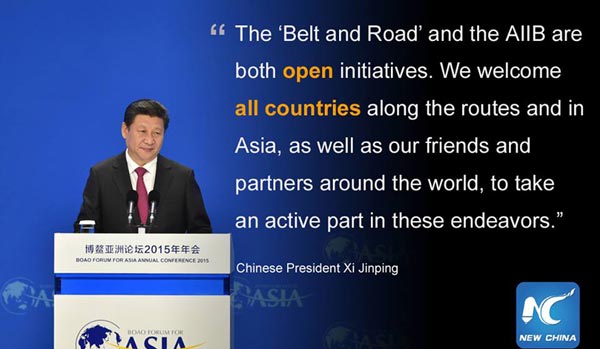

 |
| (File Photo) |
With the acceleration of the national strategy of “One Road, One Belt”, the globalization of Chinese equipment is also accelerating. According to figures released by the Ministry of Commerce, China's trade with the countries along the “One Road, One Belt” accounts for 26 percent of the total in the first quarter.
China's equipment wins confidence of the global market
Data issued by the National Development and Reform Commission shows exports of China's equipment manufacturing growing much faster than other consumer goods. In 2014 alone, exports of the equipment manufacturing industry reached 2.1 trillion yuan, accounting for 17 percent of total exports, of which locomotives took a 10 percent share and amounted to 24.8 billion yuan. This year, China has signed cooperation agreements in the area of nuclear power stations with countries including France, Argentina and South Africa and plans to build six nuclear power stations in Pakistan as well as export more nuclear reactors to the country.
In addition, China is also speeding up the pace of globalization in other fields. It has signed 28 projects worth over 14 billion yuan with Kazakhstan. These involve steel, cement, plate glass, chemicals and more.
Xu Hongcai, a researcher at the China Center for International Economic Exchanges, assigned the positive results of China's “going out” to the prospects of the “One Road, One Belt”. He said many countries have made joint efforts to planning future economic and trade cooperation.
Chinese equipment boasts a better price/performance ratio
Behind the international recognition of China's equipment manufacturing in the global market is improved performance.
Since CNR Corp and CSR Corp, which represent China's high-speed rail enterprises, announced a merger this year, they aim to be a multinational operator and global leader, which means the new unit will not only sell high-speed railway vehicles abroad, but also invest and operate in the overseas market to sharpen the whole strength of international competitiveness.
The signing of a cooperation agreement for the construction of nuclear power plants between China and Argentina recently marks the first exports of China's third generation of nuclear power technology.
The globalization of Chinese equipment is gradually moving from equipment supply to design, technology, construction, operation and maintenance, said Lu Xun, deputy director of the foreign trade division of the Ministry of Commerce.
Faced with huge demand and shortfalls in supply in Asian infrastructure, China is becoming a global infrastructure enabler and the advantage it holds is obvious, because Chinese equipment boasts a higher price/performance ratio, said economist Songqing Hui.
In addition, China has the financial muscle. Chinese financial institutions can make up for the funding gap in emerging markets and help them with their economic transformation and upgrading. The AIIB, for example, will not only inject funds into the construction of infrastructure to achieve efficient allocation of capital, but also promote economic growth in emerging countries and the development of private sectors, and improve employment.
One US dollar equals to some 6.2 yuan
 J-11 fighters in air exercise
J-11 fighters in air exercise Beauties dancing on the rings
Beauties dancing on the rings Attendants-to-be join Mr. & Miss Campus Contest
Attendants-to-be join Mr. & Miss Campus Contest Beijing's toughest anti-smoking law takes effect
Beijing's toughest anti-smoking law takes effect Family lives in cave for about 50 years in SW China
Family lives in cave for about 50 years in SW China PLA soldiers operating vehicle-mounted guns in drill
PLA soldiers operating vehicle-mounted guns in drill Blind carpenter in E China's Jiangxi
Blind carpenter in E China's Jiangxi China hosts overseas disaster relief exercise for the first time
China hosts overseas disaster relief exercise for the first time 20 pairs of twins who will become flight attendants in Sichuan
20 pairs of twins who will become flight attendants in Sichuan Obama is sowing discontent in S.China Sea
Obama is sowing discontent in S.China Sea Rescuers work through night to reach cruise ship survivors
Rescuers work through night to reach cruise ship survivors Driving through limbo
Driving through limbo Facing down MERS
Facing down MERSDay|Week